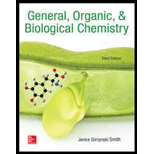
(a)
Interpretation:
The molarity of
Concept introduction:
The formula to calculate molarity is given as follows:
(b)
Interpretation:
The molarity of
Concept introduction:
The formula to calculate molarity isgiven as follows:
The conversion factor to convert
(c)
Interpretation:
The molarity of
Concept introduction:
The formula to calculate molarity is given as follows:
The formula to calculate the number of moles is given as follows:
(d)
Interpretation:
The molarity of
Concept introduction:
The formula to calculate molarity is given as follows:
(e)
Interpretation:
The molarity of
Concept introduction:
The formula to calculate molarity is,
(f)
Interpretation:
The molarity of
Concept introduction:
The formula to calculate molarity is,
The expression to calculate the number of moles is given as follows:
Want to see the full answer?
Check out a sample textbook solution
Chapter 8 Solutions
General, Organic, & Biological Chemistry
- How would you prepare 60.0 mL of 0.200 M HNO3 from a stock solution of 4.00 M HNO3? Strategy Because the concentration of the final solution is less than that of the original one, this is a dilution process.Keep in mind that in dilution, the concentration of the solution decreases but the number of moles of the solute remains the same. Solve for the volume in (mL) 4.00 M HNO3needed to prepare 60.0 mL of a 0.200 M HNO3 solutionarrow_forward5.Calculate the mole fraction of WATER in a solution of 45.0 grams of dextrose (molar mass = 180.158 g/mol) in 150.0 grams of water (molar mass = 18.0159 g/mol). Group of answer choices no correct answer 0.231 0.0291 0.972 0.769arrow_forwardFor each of the following solutions, calculate the molarity of the solution. 9.62 g MgNH4PO4 in 750. mL solution mol/L 14.7 g NaCH3COO in 400. mL solution mol/L 3.86 g CaC2O4 in 400. mL solution mol/L 9.67 g (NH4)2SO4 in 400. mL solution mol/L Submit Answerarrow_forward
- What is the molarity of 0.3882 g of KCl (MM=74.55 g/mol) in 0.5000L solution? (No solution No credit.arrow_forwardA solution is prepared by dissolving 13.5 g of glucose in 0.100 kg ofwater. What is the mass percentage of the solute in the solution?Answer: 13.5 %arrow_forwardIf 28.8 mL of 5.9 M nitric acid is diluted to 75.0 mL, what would the new molarity be? Report answer to 3 significant figures.arrow_forward
- Which response lists all the following pairs that are miscible liquids. ( Will form a solution when mixed) Pair # 1. octane (C8H18) and water Pair # 2. acetic acid (CH3COOH) and water Pair # 3. octane (C8H18) and carbon tetrachloride (CCl4) Select one: a. 2 b. 1, 2 c. 2,3 d. 3 e. 1, 3arrow_forward1. What percent solution if 11.2 g of Na2SO4 is dissolve to make 112 g of solution? Answer to 2 decimal place 2. The concentration of sugar in a soft drink is measured to be 8.60%. How many grams of sugar are in 268 g of the drink? Answer to 1 decimal place 3. If you have 3.40 g of NaOH solid, what mass of solution can be made to 0.32 % concentration? Answer to 1 decimal place 4. What mass of KF is need to prepare 440 mL of 0.12 M solution? Answer to 2 decimal places. Include the unit. 5. The concentration of sugar in a soft drink is measured to be 9.2 %. How many grams of sugar are in 196 g of the drink? Answer to 1 decimal place 6. What mass of KNO3 is need to prepare 626 mL of 0.24 M solution? Answer to 2 decimal places. Include the unit. 7. What is the molarity if 886 g of (NH4)2CO3 to make 1,716 mL of solution? Answer to 2 decimal places. Answer to 2 decimal places.arrow_forwardHow many mL of 6.0 M HCl is needed to make 1.0 L of 0.50 M HCl solution? Question 10 options: 12 mL 3.0 mL 300 mL 83 mL none of thesearrow_forward
- 2 hi Experts...please help me, i need it until 5:30 pm. Hope you can answer it before the time thank you soo much!. --Find the final concentration of the solution after adding 68 g sugar and 272 g water to 160 g solution having concentration of 20 %.arrow_forwardA chemist has 50.0 mL of a 18.0 M solution of HCl. She adds 100.0 mL of water for a total of150.0 mL of the diluted acid. What is the new concentration (molarity)? Equations- M = mol of solute /L of solution for molarity M 1 (V 1 ) = M 2 (V 2 ) for dilutionarrow_forwardHow many mL of 6.00 ppm solution are needed to make 4.00 L of a 0.100 ppm solution ? (answer = 66.7 mL) What is the dilution factor ? (answer = 1:60)arrow_forward
- Chemistry: Matter and ChangeChemistryISBN:9780078746376Author:Dinah Zike, Laurel Dingrando, Nicholas Hainen, Cheryl WistromPublisher:Glencoe/McGraw-Hill School Pub Co
